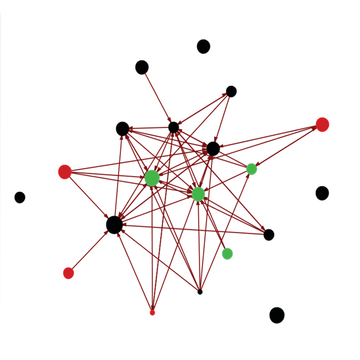
Many of us resolutely think of ourselves as independent- minded beings, free to make personal choices. But in reality, much of our decision-making hinges on our social networks—the individuals we interact with, both in person and electronically.
Gaining a better grasp on how social networks affect us, for both good and ill, is the goal of research by Ian McCulloh, a lecturer in the Whiting School’s Engineering for Professionals programs, who has studied persuasion and influence in areas as diverse as violent extremism, public health, and social media firestorms.
 “People don’t really want to acknowledge the impact that social forces play on them and their decisions, but we are inherently social creatures. It’s wired into our biology, and I think we’re dangerously unaware of what that means,” says McCulloh, who is also an adjunct professor at Johns Hopkins’ Bloomberg School of Public Health and managing director and chief data scientist for Accenture Federal Services.
“People don’t really want to acknowledge the impact that social forces play on them and their decisions, but we are inherently social creatures. It’s wired into our biology, and I think we’re dangerously unaware of what that means,” says McCulloh, who is also an adjunct professor at Johns Hopkins’ Bloomberg School of Public Health and managing director and chief data scientist for Accenture Federal Services.
As an example, McCulloh notes that more than half of the deaths in the United States are preventable because they are attributable to lifestyle choices. While smoking, drug abuse, and unhealthy eating are ultimately personal decisions, social networks play a surprisingly strong role in these behaviors, he says. He points to studies showing that obesity is socially contagious. Spending time with overweight people can change norms of food choice and body image, leading to obesity and its substantially increased risk for diabetes, heart disease, stroke, and certain cancers.
McCulloh’s current research focuses in part on the neuroscience of persuasion and how to use such knowledge to work toward better social outcomes. Toward that end, he is engaged in helping assess the effectiveness of tobacco smoking cessation and HIV prevention programs in Baltimore.
One important tool in his box is data gathered through neural imaging: real-time scans of brain activity. In one project aimed at understanding how people process public health campaign advertisements, McCulloh and his collaborators rely on functional near-infrared spectroscopy. Study subjects wear a sensor-studded cap connected to a small machine, about the size of a small notebook. The headgear shines harmless infrared light onto subjects’ scalps. The light passes through skin and bone but is absorbed differently by oxygenated hemoglobin in blood, revealing active brain regions where blood is concentrated.
Because prior research has associated brain regions with reactions including counterargument, engagement, disgust, and affirmation, McCulloh can look inside people’s heads, as it were, and see what they’re really thinking. “The neuroscience allows us to know when messages are actually landing in an effective manner,” he says.
This line of neuroscience inquiry dovetails nicely with his other research projects aimed at measuring influence that is wielded in both physical and online social networks. The work focuses on opinion leaders—people whose perspective carries extra weight in shaping a group’s attitudes toward, and reception of, information. Identifying opinion leaders and helping persuade them to support individually and socially beneficial behaviors—for instance, dietary choices, practicing safe sex, not sharing needles—can have an oversized effect on the population in question, he believes.

Another angle McCulloh is pursuing is zeroing in on so-called informal leaders. These individuals are not the formal boss, chief, or head of an organization but are the “go-to” people, counted on by many in the group as central hubs of information and implementers of policy.
Examining social networks to see who interacts with whom through what means and frequency can bring to light these movers and shakers. “You really need social network analysis to identify who are the opinion leaders and informal leaders that matter,” says McCulloh, whose overarching goal is to bring about beneficial change by gaining a better understanding of how people consume information amid the sway from those around them.
“We’re looking for social network interventions that can affect culture to avoid negative health outcomes, for instance, versus just focusing on clinical interventions,” he says. “And when we try to improve organizations, we want to look beyond the formal leaders to the influential opinion and informal leaders.”




